This was published 6 months ago
The ‘morally wrong’ restriction the police refused to follow
By Alexandra Smith and Michael Koziol

Credit: Aresna Villanueva
NSW’s COVID-19 public health orders were a one-size-fits-all approach forced upon the police, who struggled to decipher the ever-changing rules they did not request nor want, the state’s former top officer has told a panel of business and community leaders.
The former NSW Police commissioner Mick Fuller, who led the force throughout the COVID-19 pandemic, said updates to the health orders – which dictated what people could and could not do as NSW Health tried to stem the spread of the virus – often made little sense and were not always enforceable.
The orders made under the Public Health Act covered a range of restrictions at different stages of the pandemic, from how many guests could attend a wedding or funeral, to patron numbers in cafes and restaurants, trading rules and social distancing. Even who could take to a dance floor was at one stage determined by a health order.
A panel of six experts – which included Fuller – convened by The Sydney Morning Herald to interrogate NSW’s approach to lockdowns and policing agreed that the health orders lacked clarity, should have been more localised and continued for too long once COVID-19 vaccines were available. The health orders also risked creating serious social division.
Fuller said the health orders were fast-moving and did not pass the usual parliamentary scrutiny of any other legislation. For the first three months of the 2020 lockdown, NSW Police did not have a legal representative at the table as the orders were drafted.
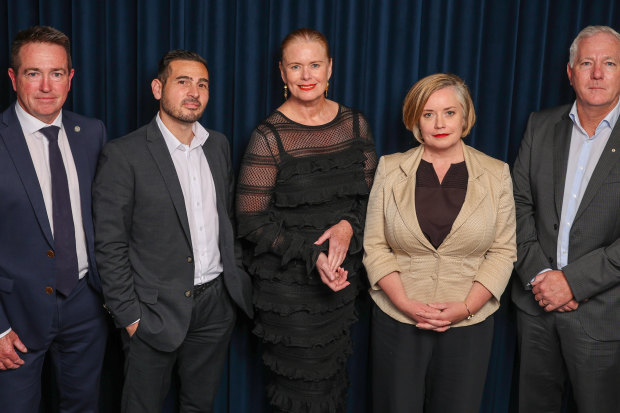
Nationals MP and former deputy premier Paul Toole; Western Sydney Leadership Dialogue chief executive Adam Leto; Tourism and Transport Forum’s Margy Osmond; former president of Local Government NSW and City of Sydney councillor Linda Scott; and former NSW Police commissioner Mick Fuller – along with mental health expert Professor Patrick McGorry who participated via Zoom – formed the Herald’s expert panel on lockdowns and policing.Credit: Dylan Coker
“There was a light-level approval process. Brad Hazzard, minister of health at the time, would sign off and ultimately that would empower those orders. Then police had to operationalise those as best as possible,” Fuller said.
Fuller said he did not know how many health orders were enacted – “I would hate to think” – but he only ever requested one. That was a $5000 on-the-spot fine for “people who cough or spit on health workers, police, pharmacists, paramedics or other public officials”.
COVID ROUNDTABLE
It’s been more than four years since China’s COVID-19 outbreak was deemed a public health emergency of international concern, heralding the start of a traumatic period many of us would prefer to forget. While a federal government inquiry is examining some national responses to the crisis, key decisions made by states will not be properly scrutinised.
The Herald is concerned our political leaders have not adequately studied the lessons – good and bad – of our most recent experience, and we asked tough questions about the pandemic’s impact on education, health and lockdowns and policing.
This is the last in our three-part series with six expert panellists looking at the impacts of border closures, lockdowns and policing during this period.
In November 2022, 33,121 of the 62,138 fines handed out since the start of the pandemic were withdrawn after Revenue NSW conceded in court that they were not valid.
Fuller said police did the best they could, bar one incident on March 31, 2020, when a convoy of five patrol cars drove through Rushcutters Bay Park, in Sydney’s east, directing people to comply with the latest social distancing orders. At the time, the eastern suburbs had been identified as a COVID hotspot.
Fuller conceded it was a “terrible” look for police. “The cops should have been out of the cars and talking to people and just explaining it,” he said. However, beyond that incident, Fuller said the police were just carrying out their job, albeit one they did not relish.
“It was a challenging time. I don’t feel as though we over-policed, but I totally understand the community disliked the health orders, and police didn’t like them either, to be honest,” Fuller said.
“One of the toughest things about the orders were the exemptions that would follow the next day.”
A city divided
While the image of police officers descending on Rushcutters Bay played on Fuller’s mind for months after, Adam Leto, the chief executive of think-tank Western Sydney Leadership Dialogue, has an equally powerful recollection.
Two months into what would become the 107-day Delta lockdown in 2021, south-western and western Sydney – home to the most ethnically diverse communities in the city – had far tighter restrictions imposed on them than the rest of NSW. Twelve council areas were declared “areas of concern” as virus case numbers climbed.
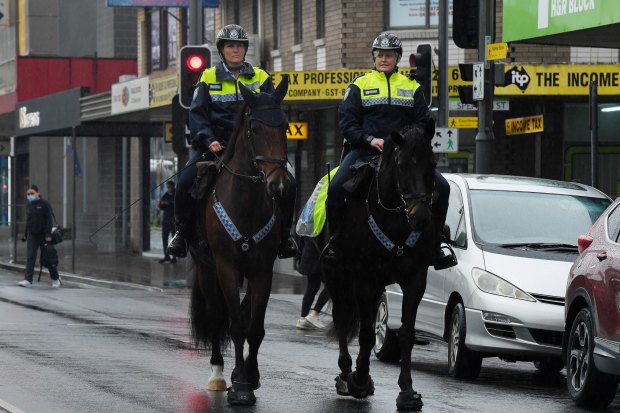
NSW mounted police patrol the streets of a locked-down Fairfield in July 2021. Credit: Kate Geraghty
By late August, those 12 hotspots were slapped with a 9pm to 5am curfew and outdoor exercise was limited to one hour a day. The rationale was that too many people were moving around western Sydney, taking the virus with them. The result was that Sydney became a city divided.
“I think there was a failure to really understand that that movement wasn’t residents spiting the government or spiting the system, it was born out of necessity,” Leto said.
“People couldn’t work at home. Some didn’t have digital connectivity. Their work required them to move. Their life required them to move. They had care responsibilities. They had extended families. So there was a lot of movement.”
Former president of Local Government NSW and City of Sydney councillor Linda Scott said she vividly recalls driving to south-western Sydney when the announcement was made, passing military personnel on the way. It was a stark difference to much of the city.
Scott said the risk of serious social unrest in western Sydney was very real. On August 20, 2021 – the day 12 areas of concern were declared – she held a press conference in her capacity as Local Government NSW president with then mayor of Canterbury-Bankstown Khal Asfour, whose council was one of the dozen affected.
There was a dangerous vacuum of information, Scott said.
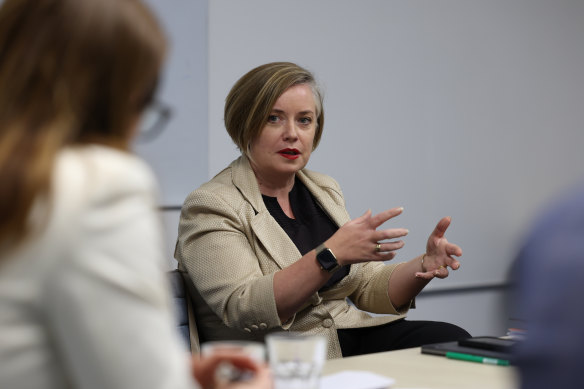
Linda Scott, president of Local Government NSW during the pandemic, addresses the Herald’s roundtable.Credit: Dylan Coker
“Nobody, none of the mayors, none of the local leaders, could tell their community what it meant for them. We couldn’t tell them why. We couldn’t tell them what it meant. None of us were clear on what people were allowed to do or not,” Scott said.
“It was a very dangerous point for social cohesion, where communities did not understand and did not accept why they had been chosen.”
Leto said western Sydney residents were watching vision of people picnicking at Bondi Beach while they were only allowed out for an hour a day for exercise. The panel agreed that far better communication was needed, involving community members and religious leaders, before the poorest areas of the city were plunged into a stricter lockdown.
The panel concurred that stay-at-home orders and restrictions needed to be “place-based”.
“Not all western Sydney is the same so your methods and your approach to Penrith are going to be different to what your message is and how you communicate that to Fairfield,” Leto said.
“It needed to be nuanced. It needed to be considered, and it needed to be consulted with local councils, with [community] leaders.”
Leto said the south-western Sydney lockdowns took him back to the Cronulla race riots of 2005.
“It had a mood and a tone to it that I could see that if it wasn’t handled appropriately, that there were enough ingredients to spark something. East versus west was real, and tensions were high. It didn’t get to that point, thankfully, and that’s a credit to the government and Mick [Fuller].”
Whiplash responses
Nationals MP and former deputy premier Paul Toole was a member of the Coalition government’s crisis cabinet, which met daily for much of the pandemic.
He said the priority “from day one” was the health of all NSW residents. That was the right approach, he said. However, that attitude continued for too long and, ultimately, at the expense of the economy.

Then-premier Dominic Perrottet with his deputy Paul Toole at the Homebush vaccination hub in October 2021.Credit: Dominic Lorrimer
The panel – which also included Professor Patrick McGorry, a leading adolescent psychiatrist and 2010 Australian of the Year – agreed with Toole’s assessment.
“If you went by the advice of Health, we would probably be in lockdown still today,” Toole, a former police minister, said.
Toole said the early days of the pandemic brought whiplash responses, as a little-known virus from Wuhan, China made its way into Australia. Suddenly, NSW was grappling with the same deadly disease that was killing people on the other side of the world.
Toole said the then-customer service minister Victor Dominello was the first to provide briefings to the cabinet and then-premier Gladys Berejiklian. Every decision, Toole said, was based on NSW Health advice. But eventually, as the pandemic dragged into its second year, the public stopped paying attention.
“There were public health orders that just kept changing. Even when the premier stood up and did an 11 o’clock presser every day, people were starting to get fatigued by the end of it,” Toole said. “There’s another public health order. There’s another change. So people then stopped listening.”
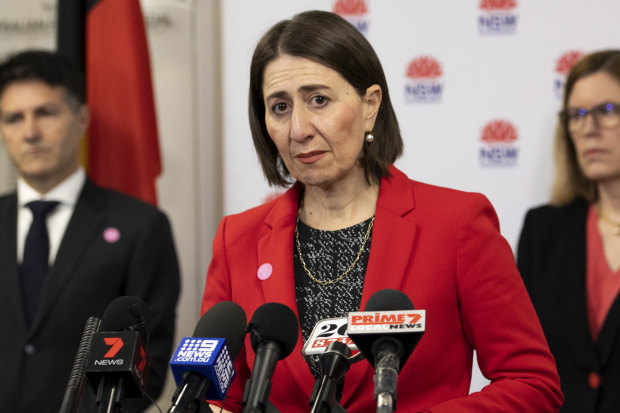
Then-NSW premier Gladys Berejiklian with Customer Service minister Victor Dominello and Chief Health Officer Kerry Chant at a COVID briefing in September 2020.Credit: Renee Nowytarger
Toole said the public health orders were often too city-centric, especially when it came to restrictions around how far people could move. “Travel in the city is very different to travel in the regions and sometimes it was, hang on, this is not going to work. This might work here in the city, but this is just ridiculous having a public health order for the regions,” Toole said.
A previous panel of health experts convened by the Herald to probe pandemic decision-making warned that while the public largely complied with health orders, the population’s willingness to forgo freedoms would not likely be repeated.
NSW Police would also be less willing to enforce the orders.
While police were responsible for enforcing the health orders, Fuller said there were some requests that could not be delivered, such as a Melbourne-style ring of steel around south-western Sydney. Hundreds of police staffed Victoria’s “ring of steel” for about four months in 2020 when Melbourne was under tighter restrictions than the rest of the state.
Fuller was asked to do the same. He refused. “There were 330 roads they wanted me to lock down. It was logistically impossible, but it was morally wrong as well,” Fuller said. There was also another flaw to that plan: local governments owned many of those roads and they had not been consulted.
Scott said it was another example of poor communication. “There was this instruction to close roads that we owned, that we didn’t know about, that we couldn’t enforce,” she said. “Everyone was trying to act in the public interest, of course, but there was a complete failure of communication about what needed to be implemented and what could be implemented.”
Ultimately, a more effective response to a ring of steel was found, Fuller said.

NSW Police Commissioner Mick Fuller, Police and Emergency Services Minister David Elliott and national commander of Operation COVID-19 Brigadier Mick Garraway address the media about the deployment of ADF officers across Greater Sydney as part of the Delta outbreak response in August 2021.Credit: James Brickwood
“It was, in fact, the local police relationships, with the imams and the other community leaders and local government, that really saved the day there, to be honest,” he said.
Keep it simple
The panel also took issue with the complex nature of the restrictions and their multitude of exemptions, saying in a future emergency they should be kept as simple as possible. Margy Osmond, head of lobby group the Tourism and Transport Forum said: “If you’re a business that has multiple outlets in different parts of the city … keeping up with all the difference was just diabolical.”
Leto said the ambiguity around the restrictions caused “tension and frustration” in western Sydney. “I think a lot of people in western Sydney thought that there was one set of rules for some and one set of rules for them,” he said.
Scott agreed. “We had great trouble interpreting the health orders and then managing the infrastructure. The curfews were very difficult in particular.”
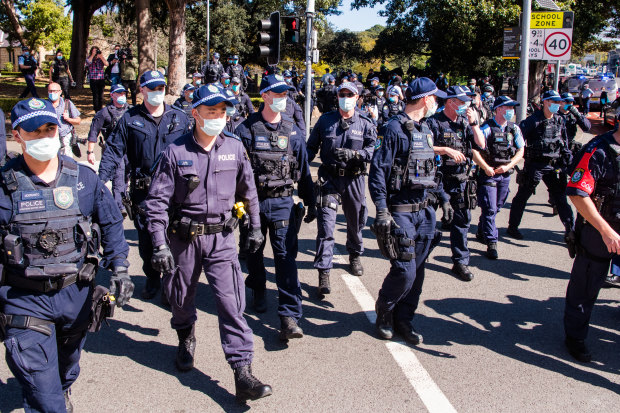
Police swarm Broadway near Sydney’s CBD to arrest anti-lockdown protesters at a rally in August 2021.Credit: James Brickwood
“We had some councils interpreting the health orders as ‘we should rope off playgrounds’, which at the time may have seemed sensible, but in retrospect probably meant that less people were using outdoor spaces and congregating indoors,” she said.
“Any decision has consequences but communication about how to interpret those things – giving a clear reason why they were put in place … would have really helped. They revealed the inequities in green space across Sydney in a very stark way.”
Fuller said some of the rules NSW eventually implemented during the Delta wave, such as the five- to 10-kilometre travel radius, were more about “trying to get the community to come on board” and understand the importance of social distancing or staying home, rather than because they had a specific purpose in stopping the spread.
“Some of them I think were more hopeful than [really thinking] they were ever going to be enforced. And I think that’s OK,” Fuller said. “We were never going to police it properly.”
Chris Minns took over as Labor opposition leader in June 2021, just before the Delta wave hit NSW, and generally offered bipartisan support for restrictions and health measures introduced by the then Coalition government.
Now as premier, Minns said it was important to reflect critically on the COVID-19 response, but would not buy into specific conclusions drawn by the Herald’s expert panel.
“At the end of the day leaders across the world were asked to make critical decisions that would impact millions of people in a very uncertain environment, based on the information they had available,” he said.
“Not every call was right, not every call was wrong. There are always things we can do better to ensure we are prepared for emergencies like another pandemic.”
Start the day with a summary of the day’s most important and interesting stories, analysis and insights. Sign up for our Morning Edition newsletter.